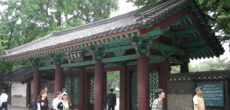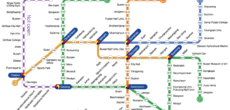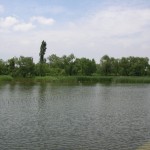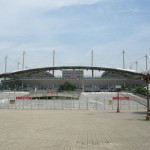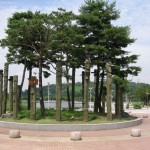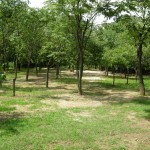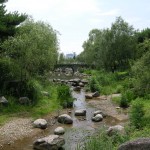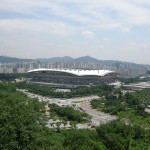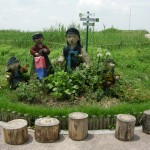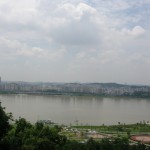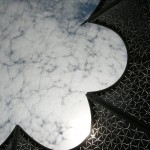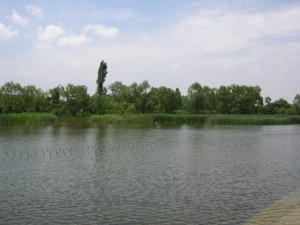
World Cup Park Seoul
The World Cup Park Seoul is made up of five parks. Neoul Park, Haneul Park, Nanji Hangang Park, Nanjicheon Park and Pyeonghwa Park. The parks are located around the World Cup Stadium and opened on May 1st, 2002 just 30 days before the start of the 17th Fifa World Cup hosted by Japan and Korea.
The parks and world cup site are located on what used to be an island called Nanjido Island. This island later got the nickname of the “Island of Death”. In the boom and development of Seoul in the 70’s the island was used as a landfill site that stretched for 2.4 kilometers and a height of 98 meters. The landfill site opened in 1978 and closed in 1993. No measures were taken to treat the waste and garbage was just left to rot. As a result the groundwater, soil and air was heavily polluted.
In 1991 the Seoul Metropolitan Government came up with a plan to prevent further environmental damage and to create a place that the citizens could enjoy. The landfill closed in 1993. It took 3 years to create plans to stabilize the landfill site. In December 1996 construction began. On May 31st, 1996 it was announced that Japan and Korea would co-host the 17th Fifa World Cup. With this new announcement, plans were quickly made to create an area for the world cup stadium and a park to commemorate this great event. In total 117 million dollars was spent on the stabilization of the landfill site and another 78 million was spent on the creation of the parks.
Enough about the facts let’s get on to the parks.
Pyeonghwa Park which means Peace Park in English. This is the first park located outside the west entrance of the World Cup Stadium. This park was built to represent the world cup event and peace and harmony between humans and nature. Located in the park is the World Cup Gallery, a play ground and a few shops and cafes. This park is very popular with families at the weekend. There are plenty of shaded areas to relax and have a picnic. There is a small lake called Nanji Lake which is a tributary to the Han River.
Nanji Hangang Park. This park is located south of Pyeonghwa Park and sits on the banks of the Hangang River and is 787,395 m2. The park was constructed as part of the Hangang Renaissance project. Nanji Hangang Park is based around an eco-friendly theme. There is a wetland area, campground and a marina. Sometimes concerts are held here such as the World DJ Festival. Other facilities include a Biking trail, Camping Area, Traditional Archery Range, Dock for Boats, Water Skiing, Boat Driver’s License Examination Centre, Bike Rentals and a Cycling Street (13.2km).
Haneul Park. Haneul Park is located in the highest place within the world cup parks which explains the name Haneul which means sky in Korean. To get to the top you must first climb 290 steps. At the top of the park you can get some stunning and breath taking views of Seoul. You can see the nearby World Cup Stadium, the Hangang River, the 63 building and the mountains surrounding Seoul. This park was originally a huge landfill pile. Many different types of plants and flowers were planted to try to restore the original ecosystem. A natural ecosystem was finally established through releasing 30,000 butterflies across the park. In keeping with environmental protection there are five wind power generators. The electricity from the generators is used to power the street lights around the world cup park.
Neoul Park. Noeul Park is a 9 hole golf course. Noeul means sunset in Korean and as you can guess, the park is a great place to view the sunset. Noeul Park was the main area for the landfill and a lot of rubbish is still buried under the golf course. Over the next few years the Seoul Metropolitan Government will began a recovery project.
Nanjicheon Park. Nanji park was once dead land made up of sewage run off from the landfill sites. However it is now bustling with nature and life following it’s restoration along with the other world cup parks. The Nanji Stream runs throughout the park filled with reeds / willows where diverse plants grow. Over 50,000 trees have been planted in Nanjicheon Park. Bicycles paths and other sports facilities are available at the park along side many rest and picnic areas.
How to get to the World Cup Parks Seoul:
Take line 6 to World Cup Stadium Station and leave exit 1. Head straight for Pyeonghwa Park. There are plenty of maps in the station and outside showing you all the locations of the parks. There is also a free shuttle bus near Mapo Agriculture -Fish Market.
View larger map


